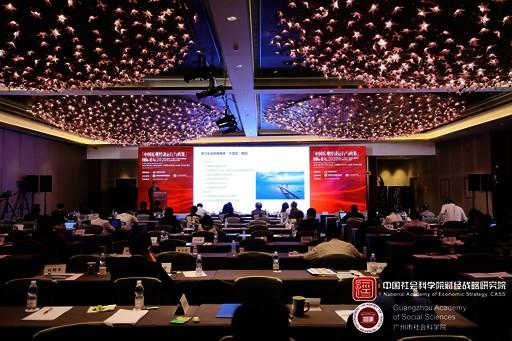
. > TOP STORIES
Greater Bay Area to ratchet up over 14th FYP
Author : WANG CHUNYAN, DU SHUANG and XIA MENG Source : Chinese Social Sciences Today 2020-12-18

The forum focuses on GBA integration and China’s new development pattern.
GUANGZHOU—The Guangdong-Hong Kong-Macao Greater Bay Area (GBA) will accelerate integrated development over the 14th Five-Year-Plan (FYP) period (2021–2025), according to experts at a forum in late November.
The forum, co-hosted by the National Academy of Economic Strategy at the Chinese Academy of Social Sciences (CASS) and the Guangzhou Academy of Social Sciences, focused on GBA integration and China’s new development pattern of dual circulation, which smooths domestic circulation and lets domestic and international circulations reinforce each other.
The past year has witnessed the shift in focus of China’s macroeconomic policy, from “six priorities” (ensuring stability in employment, financial operations, foreign trade, foreign investment, domestic investment, and expectations) to the six priorities plus stability in six areas for steady economic momentum (ensuring job security, basic living needs, operations of market entities, food and energy security, stable industrial and supply chains, and the normal functioning of primary-level governments). Now the new development pattern has become a new focus, said CASS Vice President Gao Peiyong.
Throughout this trajectory, what remains unchanged is the interweaving of cyclical, institutional, and structural contradictions, the focus on high-quality development, and a supply-side structural reform, Gao explained. Changes stem from the instability of external circumstances along with the significant increase in uncertainty. In order to cope with the impact of external circumstances, it is necessary to elevate the coordination of overall development and security, taking this as an important strategic consideration for China’s economic development and economic work in the future.
The GBA was the leader and pioneer of China’s old export-driven development pattern, and it will still play an important role in the new development pattern, said Song Hong, deputy director of the Institute of American Studies at CASS.
Zhang Yueguo, president of the Guangzhou Academy of Social Sciences, said that in order for the GBA to become an international technological innovation center with global influence, it needs to focus on the alignment of rules and mechanisms of economic operation, and focus on innovation in the fields of technology and governance. In the development of the GBA under the new development pattern, Guangzhou’s historical mission is to be a core engine of regional development.
Ni Pengfei, assistant to the director of the National Academy of Economic Strategy at CASS, said that market demand, factor supply, industrial arrangement and spatial layout all need to be taken into account to further support the integrated development of the GBA, and to support the high-quality integrated development of the Yangtze River Delta. These regions need to serve as strategic hubs for dual circulation.The functions of the GBA, the Yangtze River Delta, and the Beijing-Tianjin-Hebei urban agglomeration should be appropriately complementary, said Dai Erbiao, vice president and research director of the Asian Growth Research Institute. Their central cities should have their own characteristics, which will help promote overall national development. They need to play their role as important hubs for dual circulation, and drive the development of impoverished areas forward.
Anthony G.O. Yeh, an Academician of the Chinese Academy of Sciences and a professor at the University of Hong Kong, noted that Hong Kong must seize development opportunities offered by the GBA, and seize the new round of globalization brought about by the Belt and Road initiative, capitalizing on opportunities brought by changes in the domestic regional structure.
Ip Kuai Peng, pro-rector of the City University of Macau, said that in the construction of the GBA, the country has clearly positioned Macao as “One Center, One Platform, One Base,” making the region a global center of tourism and leisure, a commercial and trade cooperation service platform between China and Portuguese-speaking countries, and a base for exchange and cooperation where Chinese culture is the mainstream and diverse cultures coexist.
Liu Chengkun, a professor at Macau University of Science and Technology, said that the 14th FYP is an important period for Macao to integrate into the overall wave of national development and plan a new round of its own development. Under the new development pattern, Macao, which is at the intersection of domestic and international circulations, needs to accurately grasp its own role and positioning, and make use of its unique advantages.
Ye Shengtao made Chinese fairy tales from a wilderness
Ye Shengtao (1894–1988) created the first collection of fairy tales in the history of Chinese children’s literature...
-
How northern ethnicities integrated into Chinese nation
2023-09-18
-
Mogao caves
2023-09-12
-
Mogao Grottoes as ‘a place of pilgrimage’
2023-09-12
-
Time-honored architectural traditions in China
2023-08-29
-
Disentangling the civilizational evolution of China
2023-08-28
-
AI ethics in science fiction
2023-08-23













 2011-2013 by www.cssn.cn. All Rights Reserved
2011-2013 by www.cssn.cn. All Rights Reserved